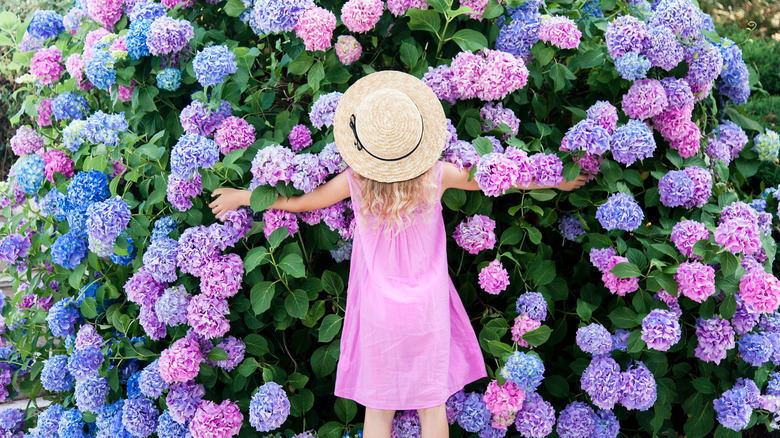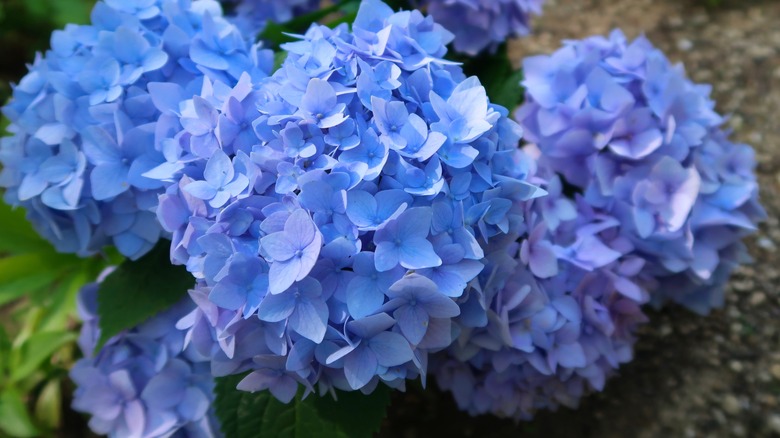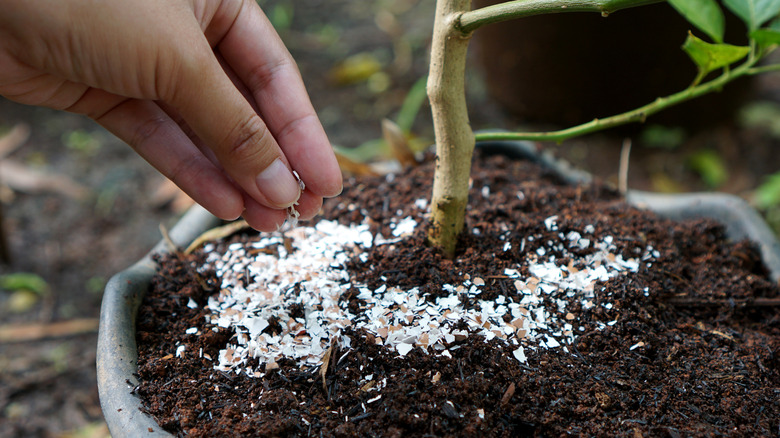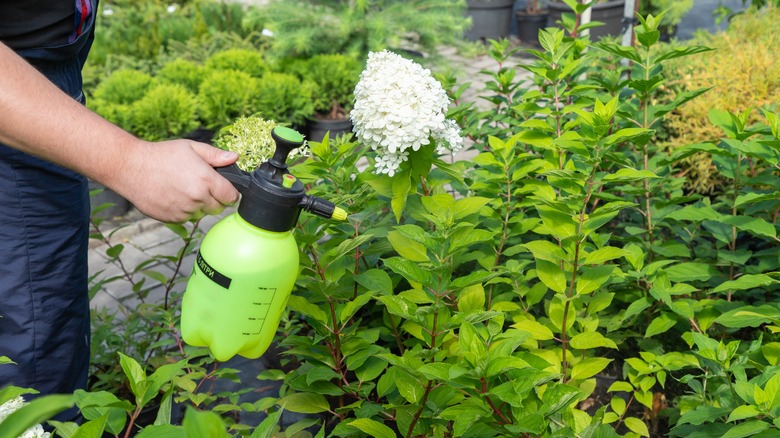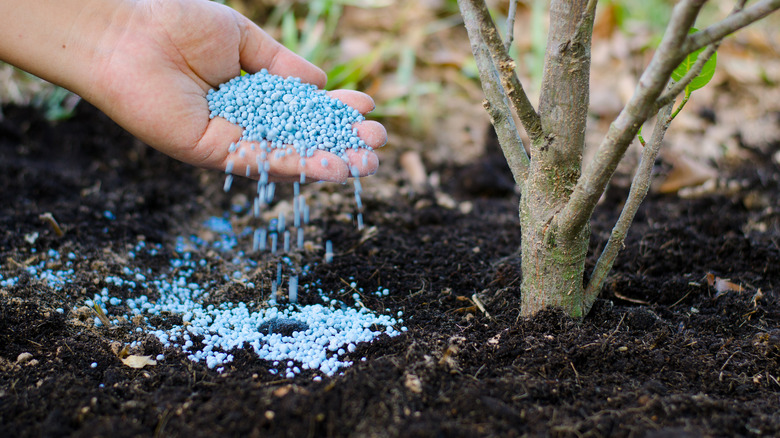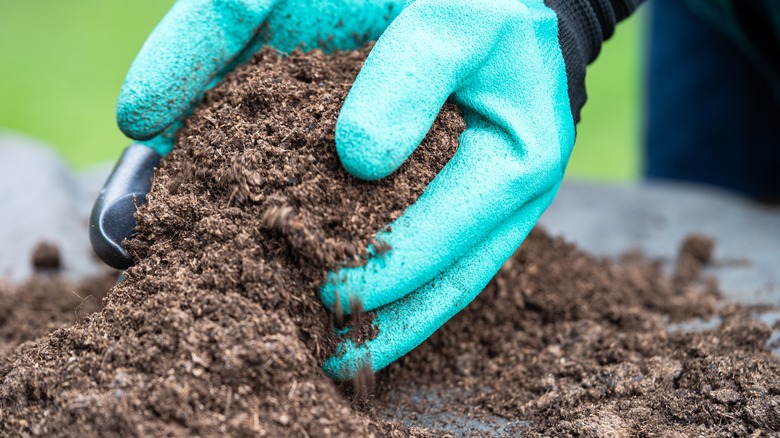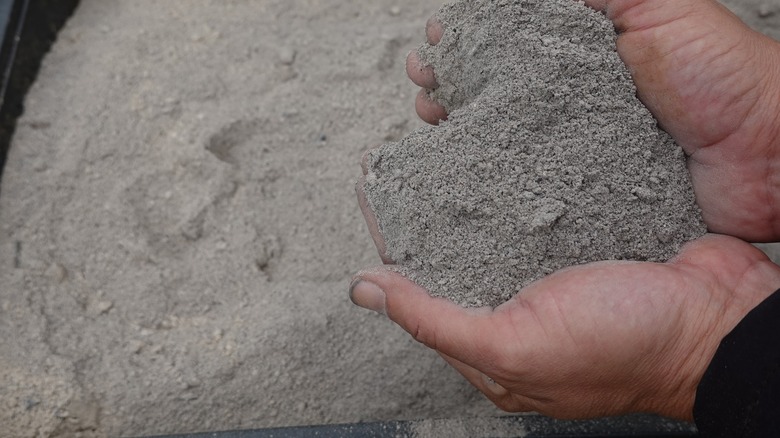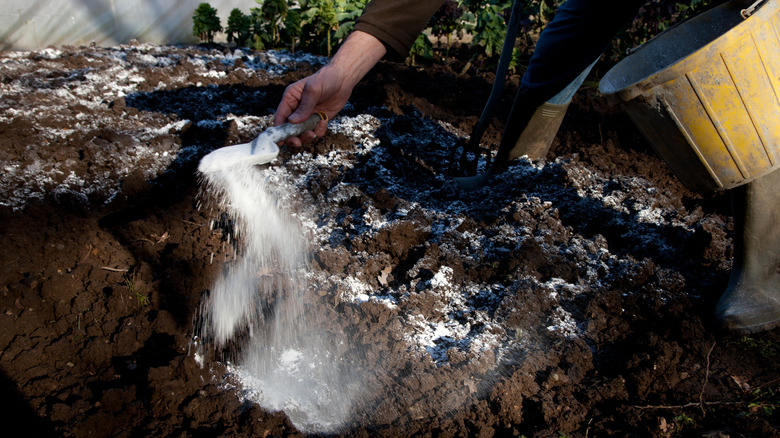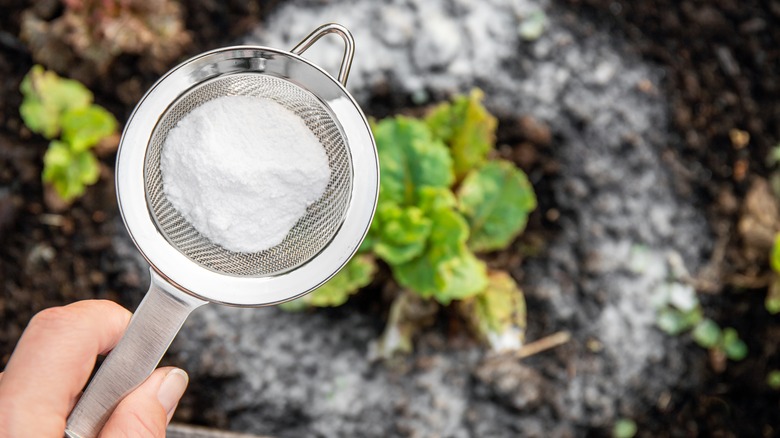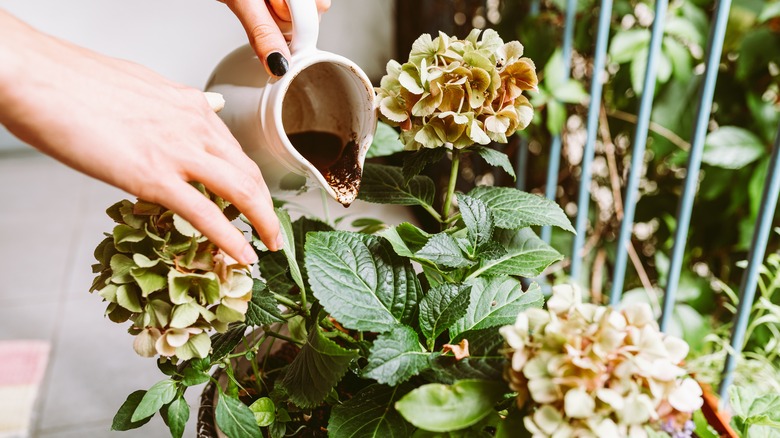10 Things That Will Change Hydrangea Color Like Magic
While white is a standard color for hydrangea bushes, you've probably seen bright blue or soft pink flowers that stand out against the green foliage. How does this happen? You may think magic is involved, and to an extent, it is. However, it's about the magic of soil science and how to add certain things to make your hydrangeas turn colors. It's not just about adding fertilizer, either. Instead, you can sprinkle specific and surprising things around the plant or mix them into the dirt to take your hydrangea flowers from white to pink, blue, or even purple. As a bonus, most of the things are minor adjustments that, with a bit of patience, make a massive difference in how your yard looks.
Knowing what to add, how long it takes to work, and what you should be cautious of can help you avoid common pitfalls gardeners make with these plants. The last thing you want to do is experiment with your huge hydrangea plant and accidentally do damage that makes you cut off parts of the plant. If you get it right, you'll get a stunning range of colors that make this plant pop and draw attention that will make all your neighbors envious.
Add aluminum sulfate to the soil
Aluminum sulfate is a chemical you add to your soil to reduce the pH levels, and this makes the hydrangeas change colors. It's especially helpful if you have pink hydrangea flowers and want to turn the color to a bright blue. However, if you expect a fast color change, you may be disappointed. Some plants absorb aluminum faster than others, and it may take a whole growing season for your hydrangeas to turn blue from pink. Also, you want to be very careful and ensure you follow the directions when you mix it into the soil because adding too much makes it toxic. Mississippi State University recommends mixing a tablespoon of aluminum sulfate into a gallon of water and applying it to the soil.
Before you apply the aluminum sulfate, ensure your plants are healthy and pest-free. After you mix the directed amount in, water them again to reduce the risk of root burn and stressing your plants and monitor the color changes.
Sprinkle crushed eggshells around the plant
You can boost your hydrangea's growth by adding a DIY calcium eggshell fertilizer, and they'll slowly make the flowers turn colors. Crushed eggshells release calcium carbonate to slowly raise the pH. Making the soil more alkaline will take white or blue hydrangea blooms and turn them pink. This is a slow process because the eggshells need time to break down once you mix them into the soil, so it could be a season before you start seeing changes.
One important thing to keep in mind is that it's a slightly vague process, and everything hinges on how fast the eggshells break down. You'll need patience and may want to consider further soil amendments, like wood ash, to shift the pH sooner. Test the soil regularly to ensure it doesn't get too alkaline because this is also bad for your hydrangeas.
Before you add crushed eggshells, wash them to get rid of any yolk or egg white residue to help keep the bugs away. Mix it around your hydrangea plant's base and water it in. Soak the soil to wash the nutrients from the shells around the root zone so the plants can absorb it and change color as the pH levels fluctuate.
Sprinkle a vinegar solution around the shrub
By adding a vinegar solution to the soil, you quickly raise the acidity and can make your hydrangea produce blue flowers. Since vinegar is so acidic, it lowers the soil's pH value, allowing your shrub to absorb aluminum more easily and create blue pigments in the flowers. You'll start seeing how the vinegar affects the soil's pH and plant bloom color within a few weeks to a month, depending on what the pH was before you applied it.
When you use this vinegar trick to turn hydrangeas from pink to blue, carefully apply it so you don't make the soil too acidic as this can damage your plants. Dilute the vinegar by adding 1 cup of it to a gallon of water to stay within safe pH levels to prevent root burn. Also, routinely test the pH levels to ensure you're setting your plant up to thrive, keeping it between 6.0 to 6.2.
Mark on the calendar when you add your diluted vinegar to the soil and reapply it every two weeks throughout the spring and summer. Reapplication will gradually shift the pH values at a rate your hydrangea can adapt to.
Mix potassium fertilizers into the soil
Adding potassium-heavy fertilizers to the dirt around your hydrangeas makes the flowers more vibrant and healthy, and it can change their coloring more toward blue. Potassium is critical for helping plants take in water and nutrients, and it strengthens the cell walls, directly affecting how vibrant and saturated the flower coloring is. Potassium won't change your soil's pH like some suggestions that are specifically meant to switch your hydrangea's coloring, but it can make your plants healthier overall. The color change is a very slow process that takes place over the course of a growing season.
When you use potassium-rich fertilizers, keep the soil's nutrient profile equal. Adding too much potassium makes it hard for your plants to absorb other nutrients, like calcium and magnesium, and this makes your plant weak. Ensure you follow any directions on the package and test the soil to see the correct amount to add before you apply anything to ensure your hydrangeas get all the nutrients they need to produce large flowers.
For this to work, start by choosing a potassium-rich fertilizer by reading the N-P-K label. If the K has a higher value, it's a potassium-rich option. The box will have detailed application instructions that will help you add the right amount, so you don't accidentally saturate the soil and cause nutrient deficiencies. You'll wait until your shrub starts growing in the spring and early summer to apply it, and reapply it as suggested.
Mix peat moss into the soil
Amending your garden soil with peat moss makes it more acidic, and this encourages your hydrangea blooms to turn more blue. With exposure to the elements, the moss will break down, sink into the soil, and lower the pH levels. As it starts to break down and mix with the soil, it'll slowly encourage the change, but this can take a full growing season before it's noticeable. However, if the environment is favorable, the moss will degrade quicker, and your flowers will change with it. Monitoring your soil's health, including the nutrient levels and pH ranges, is critical to creating the ideal environment for your hydrangea shrub. Even though this moss is great at making the soil more acidic, it can take the levels too high, and this stresses your plants.
Get your peat moss and gently pull it apart before adding an even layer straight to the soil around your hydrangeas. It'll slowly lower the pH levels as it breaks down and mixes with the planting medium to keep the acidity level stable. You can also lay the separated peat moss onto the top of the soil instead of mixing it in with the same results.
Sprinkle a light layer of wood ash
Putting a thin layer of wood ash around your hydrangea plants' base is a quick, natural way to make the soil more alkaline, which turns the blooms a light pink. This happens because potassium carbonate alters the soil's pH when combined. It makes it harder for your hydrangeas to take in certain nutrients or elements, which they need to get blue coloring. Also, if you apply the wood ash early enough in the spring before the flowers form, you'll see pink-hued blooms.
However, it's critical that you use a light hand when you mix wood ash into the soil. Routinely monitor the pH levels with a soil test and stop using wood ash if it gets too alkaline. If your soil is already naturally alkaline, add other amendments so you don't shock your plants.
Put a thin layer of wood ash around your hydrangeas, ensuring it's no more than an inch thick. Applying it thicker can turn the soil alkaline too fast, damaging your hydrangea's roots. Water the wood ash into the soil so it can start to raise the pH and sink to the root zone for fast absorption. For the best results, mix 20 pounds of wood ash into every 100 square feet, roughly 6 inches into the soil. This will gently encourage the flowers to turn pink without attracting pests or damaging the plant.
Layer sulfur chips around your hydrangea's base
Did you know that sulfur can banish pests and lower your soil's pH levels? Laying sulfur chips on the soil causes a chemical reaction that, when watered, makes sulfuric acid. The acid lowers the pH levels, making it acidic so your hydrangeas can absorb aluminum and create varying shades of blue. Since the sulfur chips need time to react and change the soil's chemistry, it'll be several months before you start seeing hints of blue on the blooms. Being patient and applying the correct amount of sulfur chips are key to keeping your plant healthy. If you add too much, the soil gets too acidic and negatively impacts your hydrangeas and surrounding plants.
Follow the dosage directions on the package to determine how much sulfur to use based on the soil's current pH levels and your hydrangea's size. Clemson University recommends applying roughly 0.05 to 0.10 pounds of sulfur for every 10 square feet of space, applied annually or every other spring. Spread it evenly around your shrub's base to the dripline, ensuring it doesn't touch the roots or foliage because it could burn them. After you lay them out, saturate the soil and chips with water to help the sulfur oxidize more quickly and bring down the pH levels.
Apply calcitic lime around the plants
Calcitic lime raises the soil's pH and makes it more alkaline to turn your hydrangea blooms pink. This lime features a large amount of calcium carbonate that neutralizes acidic soil to make it easier for your hydrangea to absorb aluminum from the surrounding planting medium. Over the span of a few months after application, you'll see the flowers slowly turning a soft pink color as the soil's chemistry changes.
However, there are things to keep in mind when you use this soil amendment. You have to measure and adjust how much you use to match the soil's pH levels to ensure you don't make it too alkaline because it damages plants. Nutrient mismatches happen when the soil is too acidic, and this stunts plant growth. So, do a soil test before you add any calcitic lime to figure out how much you need to apply, based on the package directions.
To get pink flowers, add ½ cup of calcitic lime for every 10 square feet you work with, and reapply it every two months through spring and summer. Carefully spread the ½ cup of lime around your hydrangea's base, ensuring you don't get it on the foliage or stems and burn them. Water the lime into the soil to help break it down and start raising the soil's pH levels.
Sprinkle baking soda around the plant's base
Using baking soda on your hydrangeas can slowly increase the soil's alkalinity and encourage the flowers to turn pink. It'll boost the soil's pH levels, making it hard for your hydrangea to absorb aluminum. It needs this to create blue pigments, so it'll slowly change the flower coloring to a soft pink over a few months.
The goal is to use baking soda to get the colors you want without making the soil too alkaline, and this means being careful not to use too much or reapply when the levels are already high. High alkalinity makes it difficult for your plants to absorb nutrients, and this can cause stunted growth. Test the soil's pH levels before you add baking soda and monitor the levels to ensure you're not hurting your plants. This is why patience and careful application are essential. Mix 1 teaspoon of baking soda into 2 quarts of water to dilute it to safe levels and pour it around the base of your hydrangeas, avoiding splashing the foliage.
Sprinkle used coffee grounds
There is a quick coffee ground hack you can use to get blue hydrangea flowers by making the soil slightly more acidic. The acid in used grounds will lower the pH levels, making it easy for your hydrangea to absorb nutrients like aluminum to create blue pigments. This is a slow process, and it'll take a few months or a whole growing season before the flowers get noticeably blue.
One issue with using coffee grounds is that they can lose their acidity, and this won't help keep your soil at the correct pH levels for the pretty blue blooms as it would if you used professional-grade soil acidifiers. Also, coffee grounds introduce organic matter into the soil, and they can attract fungi and pests if you overdo it.
Put a 1-inch-thick layer of grounds around your shrubs, keeping at least 1-2 inches of bare space around the stem. Refresh this layer once more in mid-summer to keep the pH values steady. As the coffee grounds start to decay, they'll sink into the soil toward the roots so your plant can absorb them. Also, ensure the soil stays moist but not soaked because saturated dirt can attract pests that can weaken your plants.
